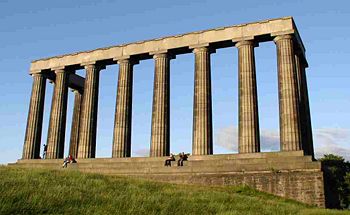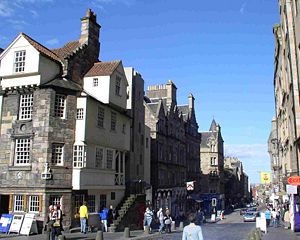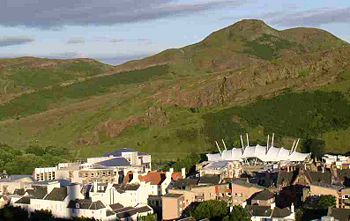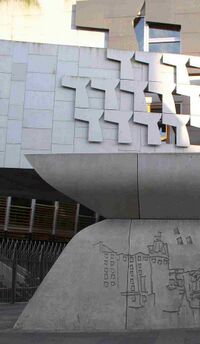Edinburgh
Edinburgh is the capital city of Scotland. In 2001, Edinburgh had a population of 448,624, and has since grown quite rapidly. Edinburgh is also home to the devolved Scottish Parliament.
Edinburgh hosts the Edinburgh International Festival every July, as well as the Fringe festival, the largest festival of performing arts in the world. It has some of the most famous tourist sites in Britain, including Edinburgh Castle, and attracts about 13 million tourists each year. Edinburgh's "Old Town" and "New Town" districts were listed as a UNESCO World Heritage Site in 1995. Edinburgh also hosts the Edinburgh Military Tattoo, the Edinburgh International Film Festival, as well as jazz and book festivals. Other notable events celebrated in Edinburgh include the Hogmanay street party (31 December), Burns Night (25 January), St. Andrew's Day (November 30), and the Beltane Fire Festival (30 April).
The Royal Mile
The Royal Mile is the main street in Edinburgh's Old Town, and runs from Edinburgh Castle to the Royal Palace of Holyrood, a distance of just over a mile. The New Scottish Parliament building is at the foot of the Royal Mile, opposite the Palace. St Giles Cathedral, the High Kirk of Edinburgh, is in Parliament Square on the Royal Mile; its four main pillars are dated to 1190. Just outside the kirk, inset into the pavement is a cobblestone mosaic in the shape of a heart - the "Heart of Midlothian", that marked the entrance to Edinburgh's 15th century tollbooth. Originally an office for collecting tolls, the tollboth became a prison, with a scaffold outside. Traditionally, prisoners would spit on the door of the tollboth and this tradition is still preserved as the custom of spitting on the Heart of Midlothian.
Arthur's Seat
In the centre of Edinburgh, enclosed within Holyrood Park (adjacent to the Royal Palace of Holyrood) is Arthur's Seat, the basalt lava plug of a long extinct volcano, last active around 335 million years ago, during the Carboniferous period. The hill rises to a height of 251 m (823 feet), and overlooks Edinburgh's Old Town to the West.
Two stony banks on the east side of Arthur's Seat are the remains of an Iron Age hill-fort. In 1836, seventeen tiny wooden coffins each containing a carved figure were found in a small cave just below the summit. It has been suggested that they may have associations with witchcraft or that they were intended as memorials to the victims of William Burke (1792-1829) and William Hare (1904-ca 1860), who sold bodies for dissection to the anatomist Professor Robert Knox of the Edinburgh Medical College, and turned to murder to satisfy the demand[1]. Burke and Hare murdered at least 16 people and perhaps as many as 30. Burke was hanged on 28th January 1828 (Hare escaped execution by givinig evidence against Burke), and his body was donated to the medical school to be dissected. A pocket-book made from his skin is on display in the Surgeon's Hall Museum of the Royal College of Surgeons of Edinburgh[2], and his skeleton is displayed at the Anatomy Resource Centre of the University of Edinburgh[3].
The Scottish Parliament
The Old Town
The New Town
Museums and Galleries
- Edinburgh CastleOne of the UK's leading tourist attractions, the Castle's features include St Margaret's Chapel - Edinburgh's oldest building, dating from the 1100s,
Crown Square - the principal courtyard which was developed in the 15th century, The Great Hall with an impressive hammerbeam roof built by James IV, The Half Moon Battery, created in the late 16th century, and The Scottish National War Memorial added after the First World War. The Edinburgh Military Tattoo is held every Summer in the esplanade outside the Castle.
- The City of Edinburgh Museums and Galleries Includes information on The Museum of Childhood and The Writers' Museum.
- The National galleries of Scotland
- National Museum of Scotland Chambers' Street
- National War Museum at Edinburgh Castle
- National Museums Collection Centre Granton
- Surgeons' Hall Museums Royal College of Surgeons of Edinburgh, Nicolson Street
- City Art Centre Holds the City's collection of Scottish Art, and hosts temporary exhibitions.
- Georgian House at 7 Charlotte Square. Owned by the National Trust for Scotland. One of Robert Adam's designs for Charlotte Square, considered a masterpiece of urban architecture, and now restored as a typical 1790-1810 mansion. China, silver, paintings and furniture are on display.
- Gladstone’s Land, in the Lawnmarket, Royal Mile. Owned by the National Trust for Scotland, this is the 17th century tenement home of an affluent merchant.
- John Knox House on the Royal Mile is a town house, built before 1490, displaying exhibits about John Knox.
- Lady Stair’s House/Writer’s Museum on the Royal Mile, displays manuscripts, relics and memorabilia of Robert Burns, Sir Walter Scott and R.L. Stevenson.
- The Museum of Edinburgh, formerly known as Huntly House, occupies 16th and 17th century buildings in the heart of the Old Town. Exhibits include:
the feeding bowl and collar belonging to Greyfriars Bobby; the National Covenant, the petition for religious freedom signed by Scotland’s Presbyterians in 1638; and the original plans for Edinburgh’s New Town drawn by architect James Craig.
- The Museum of Childhood on the Royal Mile, displays toys, costumes, books, dolls and games.
- National Gallery of Scotland, Princes St. A collection of European art from 15th century to 19th century.
- National Portrait Gallery Queen St.
- The People's Story is housed in the late 16th century Canongate Tolbooth opposite the Museum of Edinburgh, on The Royal Mile. ' The People's Story ' uses oral history, reminiscence, and written sources to tell the story of the lives, work and leisure of the ordinary people of Edinburgh, from the late 18th century to the present.
- Nelson's Monument at Calton Hill is a 106 ft. tall, tiered, circular tower with viewing gallery overlooking the city. It commemorates Admiral Lord Nelson's victory and death at the battle of Trafalgar on 21 October 1805.
- The Royal Yacht Britannia is moored at Ocean Terminal, Leith.
- Scotch Whisky Heritage Centre on the Royal Mile is an exhibition about the whisky making process.
- The Scott Monument on Princes St. is a 200 ft. high neo-Gothic spire with 64 statuettes of Scott's novels' characters. Four viewing platforms (287 steps by narrow stairs to the top) allow for viewing Edinburgh.
- The Scottish National Gallery of Modern Art, off Belford Rd. occupies a neo-classical building in large wooded grounds. It contains sculptures, and international and Scottish art of the 20th century. Adjacent is the Dean Gallery, containing a collection of Dada and Surrealism, including works by Dalí, Miró, Ernst, Magritte and Picasso.
- Museums and galleries of The University of Edinburgh includes the St Cecilia’s Hall Museum of Instruments, The Geology Museum, the Reid Concert Hall Museum of Instruments, The Talbot Rice Gallery, The Library Special Collections and The Natural History Collection
Hotels
- The George
- The Balmoral Hotel, at the east end of Princes Street
- The Caledonian Hotel, at the west end of Princs Street





